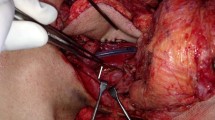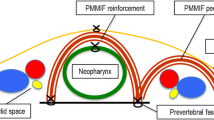Abstract
Pharyngo cutaneous fistula occurs in 16–32% of cases after laryngectomy. Repair of a non healing fistula is a reconstructive challenge due to inherent problems like malnutrition, lung infection, infected and soiled neck wound, irradiated neck field and hypothyroid status. As the defect is composite involving the neck and the aero digestive tract, there is requirement for two epithelial surfaces. The selected flaps should be thin and rigid to maintain a patent food passage and an unobstructed tracheostoma. From January 2008 to December 2016 we operated 14 cases of post laryngectomy pharyngo cutaneous fistula. 12 cases had undergone radiotherapy before laryngectomy. Duration of the fistula was 2–9 months. There was history of previous reconstructive attempts in four cases. The size of the neck defects ranged from 2 cm × 4 cm to 4 cm × 8 cm. In four cases, primary pharyngeal repair, Pectoralis major myofascial flap reinforcement and split skin grafting was done. In 10 cases, pharyngeal repair by Pectoralis major myocutaneous flap and split skin graft was done. Follow up was for 3 months to 3 years. In 13 cases, the fistula and the neck wound healed well and there was no recurrence of the fistula. Patients were on normal oral diet. One patient succumbed to the disease due to tumour recurrence at the tracheostomy site. We propose PMMF/PMMC flap and SSG for the reconstruction of post laryngectomy pharyngocutaneous fistula as an undemanding and a reliable solution.




Similar content being viewed by others
References
Redaelli de Zinis LO, Ferrari L, Tomenzoli D, Premoli G, Parrinello G, Nicolai P (1999) Postlaryngectomy pharyngocutaneous fistula: incidence, predisposing factors, and therapy. Head Neck 21(2):131–138
Ganly I, Patel S, M J, Singh B, Kraus D, Boyle Jay et al (2005) Postoperative complications of salvage total laryngectomy. Cancer 103(10):2073–2081
Galli J, De Corso E, Volante Mariangela, Almadori G, Paludetti G (2005) Postlaryngectomy pharyngocutaneous fistula: incidence, predisposing factors, and therapy. Otolaryngol Head Neck Surg 133(5):689–694
McCarthy CM, Kraus DH, Cordeiro PG (2005) Tracheostomal and cervical esophageal reconstruction with combined deltopectoral flap and microvascular free jejunal transfer after central neck exenteration. Plast Reconstr Surg 115(5):1304–1310
Isaac AB, Carroll WR, Magnuson JS, Rosenthal EL (2011) Closure of post-laryngectomy pharyngocutaneous fistulae. Head Neck Oncol 3:29
Mclean JN, Nicholas C, Duggal P, Chen A, Grist WG, Losken A, Carlson GW (2012) Surgical management of pharyngocutaneous fistula after total laryngectomy. Ann Plast Surg 68(5):442–445
Iteld L, Yu P (2007) Pharyngocutaneous fistula repair after radiotherapy and salvage total laryngectomy. J Reconstr Microsurg 23(6):339–345
Demir Z, Velidedeoğlu H, Çelebioğlu S (2005) Repair of pharyngocutaneous fistulas with the submental artery island flap. Plast Reconstr Surg 115(1):38–44
Kłos A, Gołabek W, Morshed K, Siwiec H (2003) Methods of closure for pharyngocutaneous fistula after laryngectomy. Otolaryngol Pol 57(1):59–63
Sadigh PL, Wu CJ, Feng WJ, Hsieh CH, Jeng SF (2016) New double-layer design for 1-stage repair of orocutaneous and pharyngocutaneous fistulae in patients with postoperative irradiated head and neck cancer. Head Neck 38:353–359
Min Yoo W, Suk Pae N, Pio Hong J, Kyung Lee H (2006) Treatment of pharyngocutaneous fistulae with a cork-design radial forearm free flap. J Reconstr Microsurg 22(7):483–487
Salgado CJ, Mardini S, Chen H-C, Chen S (2003) Critical oropharyngocutaneous fistulas after microsurgical head and neck reconstruction: indications for management using the “tissue-plug” technique. Plast Reconstr Surg 112(4):957–963
Moradi P, Glass GE, Atherton DD, Eccles S, Coffey M, Majithia A, Speirs AJD, Clarke PM, Wood SH (2010) Reconstruction of pharyngolaryngectomy defects using the jejunal free flap: a 10-year experience from a single reconstructive center. Plast Reconstr Surg 126(6):1960–1966
Jing SS, O’Neill T, Clibbon JJ (2014) A comparison between free gracilis muscle flap and pedicled pectoralis major flap reconstructions following salvage laryngectomy. J Plast Reconstr Aesthet Surg 67(1):17–22
Johnson A, Francis M, DiPietro L (2014) Differential apoptosis in mucosal and dermal wound healing. Adv Wound Care (New Rochelle) 3(12):751–761
Calli C, Pinar E, Oncel S (2011) Pharyngocutaneous fistula after total laryngectomy: less common with mechanical stapler closure. Ann Otol Rhinol Laryngol 120(5):339–344
Iglesias-Moreno MC, Gimeno-Hernández J, Gómez-Serrano M, Carricondo F, Gil-Loyzaga P, Poch-Broto J (2011) Pharyngo-cutaneous fistula: An old problem revisited. Acta Otolaryngol 131(12):1311–1318
Hamahata A, Beppu T, Saitou T, Kubo K, Shirakura S, Hatanaka A et al (2013) The usefulness of triple layers suturing technique with frilled pectoralis major musculocutaneous flap for pharyngocutaneous fistula. J Plast Reconstr Aesthet Surg 67(1):32–33
Author information
Authors and Affiliations
Corresponding author
Ethics declarations
Conflicts of interest
There are no conflicts of interest.
Rights and permissions
About this article
Cite this article
Hariharan, N.C., Sugumar, M. & Muthukumar, R. Pectoralis Major Myocutaneous/Myofascial Flap and Split Skin Grafting for Repair of Post Laryngectomy Pharyngo Cutaneous Fistula: An Undemanding and a Reliable Solution. Indian J Otolaryngol Head Neck Surg 71 (Suppl 1), 305–311 (2019). https://doi.org/10.1007/s12070-018-1288-5
Received:
Accepted:
Published:
Issue Date:
DOI: https://doi.org/10.1007/s12070-018-1288-5




